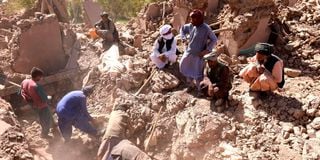Premium
Magnitude 6.3 earthquake hits Afghanistan's Herat city

Afghan residents clear debris as they look for victims' bodies in the rubble of damaged houses after the earthquakes in Kashkak village, Zendeh Jan district of Herat province on October 8, 2023.
What you need to know:
- On October 7, another magnitude 6.3 quake and eight powerful aftershocks jolted the same part of Herat, killing over 1,000 people and wounding hundreds more.
- Most homes in rural Afghanistan are made of mud and built around wooden support poles, with little in the way of steel or concrete reinforcement.
A shallow 6.3 magnitude earthquake rocked western Afghanistan on Sunday, the US Geological Survey said, the latest to hit a region where entire villages have been flattened and over 1,000 killed by a series of tremors this month.
The quake hit at 0336 GMT, 33 kilometres (20 miles) from Herat city, the capital of the western province of the same name, the USGS said.
On October 7, another magnitude 6.3 quake and eight powerful aftershocks jolted the same part of Herat, toppling swathes of rural homes and killing over 1,000 people and wounding hundreds more.
Days later, with thousands of terrified residents left without shelter and volunteers digging for survivors, another tremor of the same intensity killed one person and injured 130 others.
More than 90 per cent of those killed in the quakes were women and children, UNICEF said on Wednesday.
The United Nations said more than 12,000 people were affected by the tremors.
Providing shelter on a large scale will be a challenge for Afghanistan's Taliban authorities, who seized power in August 2021, and have fractious relations with international aid organisations.
Most homes in rural Afghanistan are made of mud and built around wooden support poles, with little in the way of steel or concrete reinforcement.
Multi-generational extended families generally live under the same roof, meaning serious earthquakes can devastate communities.
Afghanistan is already suffering a dire humanitarian crisis, with the widespread withdrawal of foreign aid following the Taliban's return to power.




